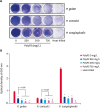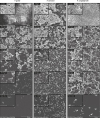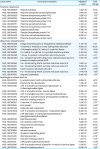1. Bodet C, Chandad F, Grenier D. Pathogenic potential of
Porphyromonas gingivalis, Treponema denticola and
Tannerella forsythia, the red bacterial complex associated with periodontitis. Pathol Biol (Paris). 2007; 55:154–162.

2. Socransky SS, Haffajee AD, Cugini MA, Smith C, Kent RL Jr. Microbial complexes in subgingival plaque. J Clin Periodontol. 1998; 25:134–144.

3. Dahlén GG. Black-pigmented gram-negative anaerobes in periodontitis. FEMS Immunol Med Microbiol. 1993; 6:181–192.

4. Ximénez-Fyvie LA, Haffajee AD, Socransky SS. Microbial composition of supra- and subgingival plaque in subjects with adult periodontitis. J Clin Periodontol. 2000; 27:722–732.

5. Harvey CE. Periodontal disease in dogs. Etiopathogenesis, prevalence, and significance. Vet Clin North Am Small Anim Pract. 1998; 28:1111–1128.
6. Harvey CE, Emily PP. Small Animal Dentistry. St. Louis: Mosby-Year Books;1993.
7. Stephan B, Greife HA, Pridmore A, Silley P. Activity of pradofloxacin against
Porphyromonas and
Prevotella spp. Implicated in periodontal disease in dogs: susceptibility test data from a European multicenter study. Antimicrob Agents Chemother. 2008; 52:2149–2155.

8. DeBowes LJ, Mosier D, Logan E, Harvey CE, Lowry S, Richardson DC. Association of periodontal disease and histologic lesions in multiple organs from 45 dogs. J Vet Dent. 1996; 13:57–60.

9. Okuda K, Kato T, Ishihara K. Involvement of periodontopathic biofilm in vascular diseases. Oral Dis. 2004; 10:5–12.

10. Scannapieco FA, Bush RB, Paju S. Associations between periodontal disease and risk for nosocomial bacterial pneumonia and chronic obstructive pulmonary disease. A systematic review. Ann Periodontol. 2003; 8:54–69.

11. Collins MD, Love DN, Karjalainen J, Kanervo A, Forsblom B, Willems A, Stubbs S, Sarkiala E, Bailey GD, Wigney DI, Jousimies-Somer H. Phylogenetic analysis of members of the genus
Porphyromonas and description of
Porphyromonas cangingivalis sp. nov. and
Porphyromonas cansulci sp. nov. Int J Syst Bacteriol. 1994; 44:674–679.

12. Fournier D, Mouton C, Lapierre P, Kato T, Okuda K, Ménard C.
Porphyromonas gulae sp. nov., an anaerobic, gram-negative coccobacillus from the gingival sulcus of various animal hosts. Int J Syst Evol Microbiol. 2001; 51:1179–1189.

13. Allaker RP, de Rosayro R, Young KA, Hardie JM. Prevalence of
Porphyromonas and
Prevotella species in the dental plaque of dogs. Vet Rec. 1997; 140:147–148.

14. Isogai H, Kosako Y, Benno Y, Isogai E. Ecology of genus Porphyromonas in canine periodontal disease. Zentralbl Veterinarmed B. 1999; 46:467–473.
15. Kornberg A, Rao NN, Ault-Riché D. Inorganic polyphosphate: a molecule of many functions. Annu Rev Biochem. 1999; 68:89–125.

16. Ellinger RH. Phosphates in food processing. In : Furia TE, editor. CRC Handbook of Food Additives. Cleveland: CRC Press;1972. p. 617–780.
17. Deshpande SS. Food additives. In : Deshpande SS, editor. Handbook of Food Toxicology. New York: Marcel Dekker;2002. p. 258–261.
18. Lanigan RS. Final report on the safety assessment of sodium metaphosphate, sodium trimetaphosphate, and sodium hexametaphosphate. Int J Toxicol. 2001; 20:Suppl 3. 75–89.

19. Ritz E, Hahn K, Ketteler M, Kuhlmann MK, Mann J. Phosphate additives in food--a health risk. Dtsch Arztebl Int. 2012; 109:49–55.
20. Knabel SJ, Walker HW, Hartman PA. Inhibition of
Aspergillus flavus and selected gram-positive bacteria by chelation of essential metal cations by polyphosphates. J Food Prot. 1991; 54:360–365.

21. Lee RM, Hartman PA, Stahr HM, Olson DG, Williams FD. Antibacterial mechanism of long-chain polyphosphates in
Staphylococcus aureus
. J Food Prot. 1994; 57:289–294.

22. Moon JH, Park JH, Lee JY. Antibacterial action of polyphosphate on
Porphyromonas gingivalis
. Antimicrob Agents Chemother. 2011; 55:806–812.

23. Jang EY, Kim M, Noh MH, Moon JH, Lee JY.
In vitro effects of polyphosphate against
Prevotella intermedia in planktonic phase and biofilm. Antimicrob Agents Chemother. 2015; 60:818–826.

24. Slots J, Jorgensen MG. Effective, safe, practical and affordable periodontal antimicrobial therapy: where are we going, and are we there yet? Periodontol 2000. 2002; 28:298–312.

25. Clinical and Laboratory Standards Institute (CLSI). Methods for antimicrobial susceptibility testing of anaerobic bacteria. Approved standard-seventh edition. CLIS document M11-A7. Wayne: CLSI;2007.
26. Moon JH, Jang EY, Shim KS, Lee JY.
In vitro effects of
N-acetyl cysteine alone and in combination with antibiotics on
Prevotella intermedia
. J Microbiol. 2015; 53:321–329.

27. Moon JH, Lee JH, Lee JY. Microarray analysis of the transcriptional responses of
Porphyromonas gingivalis to polyphosphate. BMC Microbiol. 2014; 14:218.

28. Cummins CS, Harris H. The chemical composition of the cell wall in some gram-positive bacteria and its possible value as a taxonomic character. J Gen Microbiol. 1956; 14:583–600.

29. Darveau RP, Hajishengallis G, Curtis MA.
Porphyromonas gingivalis as a potential community activist for disease. J Dent Res. 2012; 91:816–820.

30. Davis IJ, Wallis C, Deusch O, Colyer A, Milella L, Loman N, Harris S. A cross-sectional survey of bacterial species in plaque from client owned dogs with healthy gingiva, gingivitis or mild periodontitis. PLoS One. 2013; 8:e83158.

31. Raschke M, Bürkle L, Müller N, Nunes-Nesi A, Fernie AR, Arigoni D, Amrhein N, Fitzpatrick TB. Vitamin B1 biosynthesis in plants requires the essential iron sulfur cluster protein, THIC. Proc Natl Acad Sci U S A. 2007; 104:19637–19642.

32. Du Q, Wang H, Xie J. Thiamin (vitamin B1) biosynthesis and regulation: a rich source of antimicrobial drug targets? Int J Biol Sci. 2011; 7:41–52.

33. Winkler W, Nahvi A, Breaker RR. Thiamine derivatives bind messenger RNAs directly to regulate bacterial gene expression. Nature. 2002; 419:952–956.

34. Serganov A, Polonskaia A, Phan AT, Breaker RR, Patel DJ. Structural basis for gene regulation by a thiamine pyrophosphate-sensing riboswitch. Nature. 2006; 441:1167–1171.

35. Finn RD, Coggill P, Eberhardt RY, Eddy SR, Mistry J, Mitchell AL, Potter SC, Punta M, Qureshi M, Sangrador-Vegas A, Salazar GA, Tate J, Bateman A. The Pfam protein families database: towards a more sustainable future. Nucleic Acids Res. 2016; 44:D1. D279–D285.

36. Bartlett PN. Bioenergetics and biological electron transport. In : Bartlett PN, editor. Bioelectrochemistry: Fundamentals, Experimental Techniques and Applications. Chichester: John Wiley & Sons Ltd;2008. p. 1–32.
37. Maguire BA. Inhibition of bacterial ribosome assembly: a suitable drug target? Microbiol Mol Biol Rev. 2009; 73:22–35.

38. Emerson JE, Stabler RA, Wren BW, Fairweather NF. Microarray analysis of the transcriptional responses of
Clostridium difficile to environmental and antibiotic stress. J Med Microbiol. 2008; 57:757–764.

39. Mikkola R, Kurland CG. Evidence for demand-regulation of ribosome accumulation in E coli. Biochimie. 1991; 73:1551–1556.

40. Ng WL, Kazmierczak KM, Robertson GT, Gilmour R, Winkler ME. Transcriptional regulation and signature patterns revealed by microarray analyses of
Streptococcus pneumoniae R6 challenged with sublethal concentrations of translation inhibitors. J Bacteriol. 2003; 185:359–370.













 PDF
PDF Citation
Citation Print
Print



 XML Download
XML Download